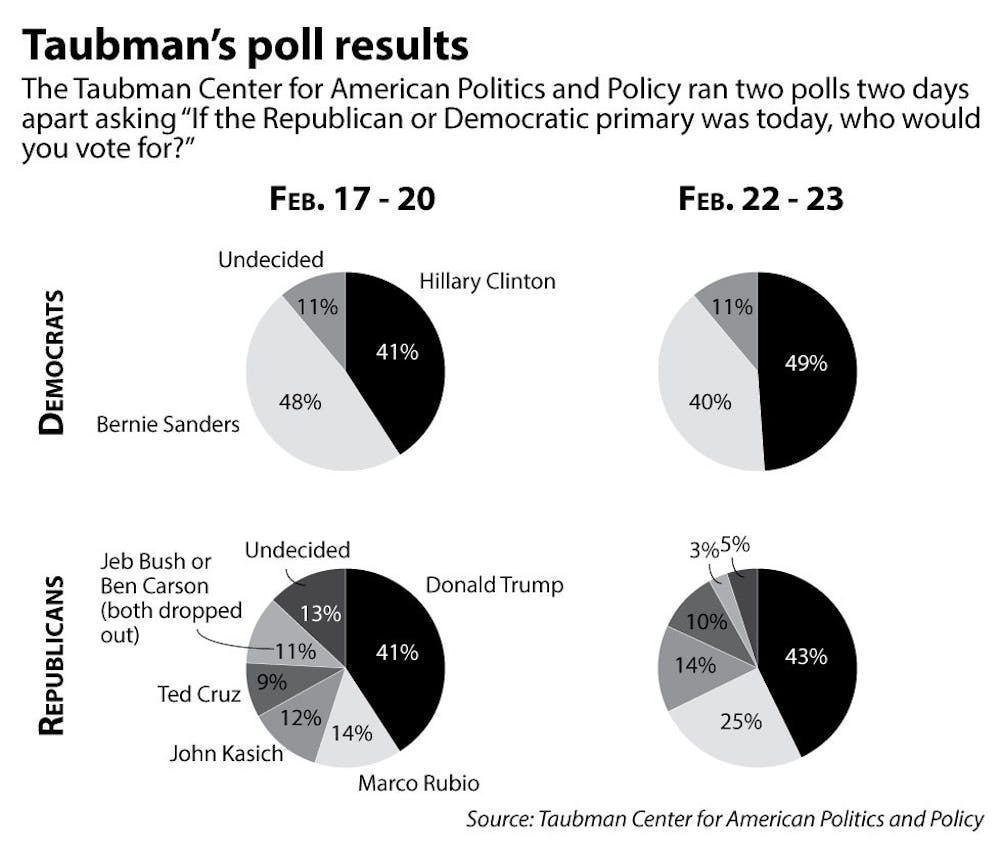The Taubman Center for American Politics and Policy released two public opinion polls Feb. 25 about the 2016 Rhode Island presidential primaries, which will take place April 26. The polls found that Hillary Clinton holds a nine-point lead over U.S. Sen. Bernie Sanders, D-VT, and Donald Trump leads the Republican candidates by 18 points or more.
The results reflect the opinions of 600 likely Rhode Island primary voters, resulting in a margin of error of four points. The polls were conducted Feb. 17-20 and Feb. 22-23, the latter period of which took place after the Nevada Democratic Caucus and the South Carolina Republican Primary.
The polls showed an eight point gain to Clinton at a cost to Sanders, as the senator led 48 percent to Clinton’s 41 in the first poll but trailed 49-40 in the second. In both polls, 11 percent of Democratic voters were undecided.
In addition, Clinton gained support from black voters making under $75,000 per year and voters under the age of 30, though Sanders still leads the latter group by a significant margin.
Clinton’s lead in the second poll can be attributed to the fact that she won Nevada’s Democratic Caucus, said Elena Saltzman ’16, co-president of Brown Students for Hillary. Because the state shares a similar demographic to the country, it “reassured voters,” she said.
Clinton has also been fighting for issues that affect vulnerable populations her entire life, and voters “are becoming more cognizant of that,” said Emma Dickson ’16, co-president of Brown Students for Hillary.
But Roro Oshobe ’19, a coordinator for Brown University Students for Bernie, said the media has created and perpetuates a narrative that Sanders can’t win the general election. “If people knew more about where Bernie stands, then more people would vote for him,” Oshobe added.
On the opposite side of the aisle, Trump continues to hold a comfortable lead among Republicans. In the second poll, Trump stood at 43 percent, U.S. Sen. Marco Rubio, R-FL, received 25 percent, Gov. John Kasich of Ohio 14 percent, U.S. Sen. Ted Cruz, R-TX, 10 percent and Ben Carson 3 percent. Rubio made the most significant gain, picking up 11 points between polls.
Trump’s popularity among Republicans can be explained by the populist movement sweeping through the party, said James Morone, director of the Taubman Center. Trump is mobilizing voters in record turnouts and redefining the GOP’s platform, such that “we may be seeing something in the Republican Party that echoes for a generation,” he added.
The poll also found that the leading candidates in each party tended to be rated as more unfavorable. In the second poll, Clinton received a favorable/unfavorable rating of 49 percent/46 percent while Sanders posted a rating of 56 percent/37 percent. Meanwhile, in both polls, Trump had the second highest unfavorable rating among Republicans at 63 percent and the third highest favorable rating at 32 percent.
Saltzman and Dickson attributed Clinton’s lower favorable rating to two possible factors: Clinton has been in the national spotlight for much longer than Sanders, and Republicans tend to focus their attacks on her.
The high unfavorable ratings among the candidates indicate that the presidential race is still fluid, Morone said. The poll numbers are subject to change given recent developments, such as the results of Super Tuesdays one and two, Super Saturday and the suspension of Jeb Bush’s and Carson’s respective campaigns, he added.
“Fasten your seat belts — it’s going to be a bumpy ride,” Morone said.





